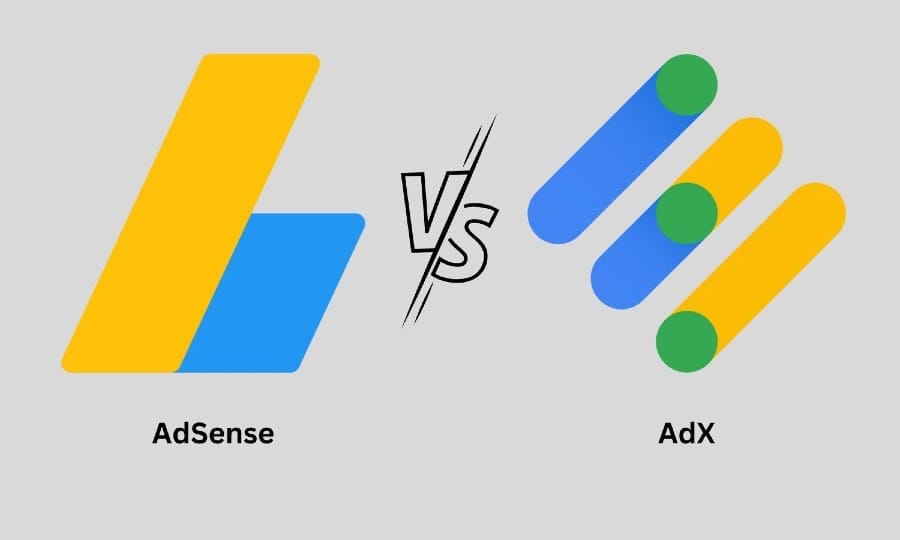Google AdSense vs. AdX

In the ever-evolving landscape of online advertising, website owners and bloggers face a multitude of choices when it comes to monetizing their content. Two titans within the Google ecosystem, AdSense and AdX (Ad Exchange), stand out as popular options, but their functionalities and target audiences differ significantly. This comprehensive guide delves into the intricacies of both platforms, exploring their advantages, limitations, and the potential benefits of running them concurrently.
Google AdSense: A User-Friendly Gateway to Monetization
Imagine a visitor landing on your travel blog. AdSense, functioning as an ad network, analyzes the content and user demographics. It then seamlessly integrates relevant contextual ads, like travel insurance or hotel booking options, within your website. This user-friendly platform offers several benefits for publishers:
- Effortless Setup and Management: AdSense boasts a straightforward setup process. Simply sign up, generate an ad code, and paste it onto your website. Google takes care of the rest, selecting and displaying relevant ads. This makes it ideal for beginners who lack extensive technical knowledge.
- Accessibility for All Traffic Levels: Unlike AdX, AdSense has no minimum traffic requirements. Whether you're a budding blogger with a niche audience or a website experiencing moderate growth, AdSense allows you to start generating ad revenue early on in your journey.
- Minimal Ongoing Maintenance: Once the ad code is implemented, AdSense requires minimal ongoing management. Google handles ad serving, optimization, and reporting, freeing you to focus on creating compelling content for your website.
Limitations of AdSense to Consider
While AdSense offers undeniable ease of use, there are a few limitations to be aware of:
- Limited Control: AdSense prioritizes user experience by automatically selecting and displaying ads. Publishers have minimal control over which ads appear on their website, potentially leading to irrelevant or visually disruptive placements.
- Lower Revenue Potential: AdSense primarily relies on Google Ads advertisers, leading to a smaller pool of bidders. This can translate to lower revenue per thousand impressions (RPM) compared to AdX, where real-time bidding drives up competition for high-quality inventory.
- Limited Ad Format Flexibility: Publishers are restricted to a narrower range of ad formats with AdSense, primarily consisting of display ads, text ads, and in-feed ads. This limits opportunities to cater to diverse advertiser demands and potentially reduces user engagement.
Unveiling the Power of AdX: A Platform for Growth-Oriented Publishers
Think of AdX as a bustling marketplace where publishers can sell their ad inventory to a wider pool of potential buyers. Unlike AdSense's reliance on a single source, AdX connects you with a diverse range of players:
- Demand-Side Platforms (DSPs): These platforms aggregate ad inventory from numerous publishers and allow advertisers to bid on it programmatically, fostering increased competition.
- Ad Networks: Similar to AdSense, ad networks act as intermediaries between publishers and advertisers. However, AdX provides access to a broader network beyond just Google Ads, expanding your reach to a wider pool of potential advertisers.
- Direct Advertisers: AdX empowers you to connect with advertisers directly, allowing you to negotiate fixed-price deals (programmatic deals) or explore private auctions for premium ad placements.
Unlocking the Advantages of AdX
By embracing AdX, you gain access to several advantages that can significantly impact your website's monetization potential:
- Higher Revenue Potential: AdX utilizes real-time bidding (RTB). In this dynamic auction environment, advertisers compete in real-time for ad impressions, potentially driving up the price for your ad inventory, particularly for high-quality traffic.
- Granular Control: AdX offers publishers a significant degree of control over the ads displayed on their website. You can set minimum bids, block specific advertisers, choose the types of ads to be displayed, and define excluded categories. This allows for superior ad quality control and a more optimized user experience.
- Wider Range of Ad Formats: Go beyond traditional display ads! AdX supports a broader variety of ad formats, including video ads, rich media ads, and native ads. This enables you to cater to a wider range of advertiser demands and potentially increase user engagement with more visually appealing ad placements.
Understanding the Drawbacks of AdX Before You Dive In
While AdX is a potent tool, there are a few drawbacks to consider:
- Higher Traffic Requirements: AdX typically has higher traffic requirements compared to AdSense. Publishers with substantial and well-established audiences are generally better suited for this platform. A minimum threshold of monthly visitors might be unofficially enforced, though Google doesn't explicitly state a specific number.
- Complex Setup and Management: Setting up and managing AdX can be more intricate than AdSense. Integrating AdX with your website and optimizing campaigns for maximum yield may require technical expertise or working with a professional.
Why Running AdSense and AdX Together Can Be a Winning Strategy
While the choice between AdSense and AdX often appears binary, a growing number of publishers are discovering the benefits of a hybrid approach. Here's why running both platforms concurrently can be a strategic move:
- Complementing Strengths, Mitigating Weaknesses: AdSense excels in user-friendliness and accessibility, making it ideal for lower-traffic websites or those with limited technical resources. Meanwhile, AdX unlocks higher revenue potential and granular control for established publishers with significant traffic. By utilizing both platforms, you leverage their individual strengths while mitigating their weaknesses.
- Maximizing Inventory Fill Rates: AdSense acts as a backstop, ensuring that even if there aren't enough bidders on AdX for a particular impression, an ad from the Google Ads network can still fill the slot and generate some revenue. This helps to minimize instances of empty ad placements.
- A Testing Ground for AdX: Running AdSense alongside AdX allows you to collect valuable data on ad performance and user experience. This data can then be used to strategically optimize your AdX campaigns for maximum effectiveness when you're ready to invest more heavily in this platform.
- Diversifying Revenue Streams: By leveraging two separate ad networks, you're not putting all your eggs in one basket. This diversification can be particularly beneficial if disruptions occur within either AdSense or AdX, mitigating the financial impact.
However, it's important to be aware of a few caveats when considering a hybrid approach:
- Potential for Ad Blocking: Running too many ads on a single webpage can lead to user frustration and ad blocking. Careful ad placement and format selection are crucial to maintain a positive user experience.
- Management Overhead: Managing two platforms requires additional time and effort. Ensure you have the resources in place to effectively monitor and optimize both AdSense and AdX campaigns.
Choosing the Right Path: AdSense vs. AdX – A Strategic Decision
The optimal choice between AdSense, AdX, or a hybrid approach hinges on various factors specific to your website's growth stage and your technical capabilities. Here's a roadmap to guide you in making an informed decision:
Embrace AdSense if:
- Your website is in its early stages of development, with a growing audience but below a potential AdX traffic threshold.
- You're a beginner with limited technical knowledge and prefer a user-friendly platform.
- You prioritize ease of use and require minimal ongoing management.
- **You're comfortable with potentially lower revenue per impression in exchange for a simpler setup.
Consider AdX if:
- Your website boasts a high volume of established traffic, attracting a significant audience.
- You have the technical expertise or resources to manage a more complex platform.
- You desire granular control over ad selection, placement, and pricing to optimize user experience and ad quality.
- You're aiming to maximize your ad revenue potential and leverage real-time bidding for potentially higher returns.
Explore a Hybrid Approach if:
- You have a growing website with moderate traffic and some technical capabilities.
- You want to balance user experience with maximizing potential revenue.
- You desire a safety net to ensure ad fill rates.
Consider Third-Party Ad Servers if:
- Your website has exceptionally high traffic and complex ad needs.
- You have a dedicated team with extensive technical expertise.
- You require even greater control and customization beyond what AdX offers.
Conclusion: A Symphony of Monetization Strategies
Understanding the nuances of Google AdSense and AdX empowers you to create a strategic monetization plan for your website. AdSense serves as a user-friendly entry point, ideal for beginners and websites with lower traffic. AdX unlocks a world of possibilities for established publishers with significant traffic and technical expertise, offering real-time bidding, granular control, and the potential for higher revenue.
Remember, the optimal solution might lie in a hybrid approach or exploring third-party ad servers as your website evolves. By carefully evaluating your needs and resources, you can select the platform or combination of platforms that best harmonizes with your website's growth strategy, allowing you to effectively monetize your content and achieve your financial goals.
